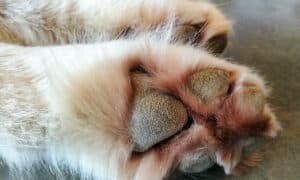“This post contains affiliate links, and I will be compensated if you make a purchase after clicking on my links.”
Degenerative myelopathy, or DM, is the veterinary term for a disease commonly called hind-end weakness. If you have a dog, or are thinking about getting one, hind-end weakness is a dog disease you should know about. I have most often heard of it affecting the German Shepherds, but authoritative sources indicate that it has been documented as afflicting a number of breeds.
Dr. Bernhard Pukay, writing in the Ottawa Citizen, discusses the cause of hind-end weakness, and some of the things you can do to slow the progression of the disease.
Hind-end Weakness is a Dog Disease You Should Know About
Q: A few months ago, we had to euthanize our 12-year-old German shepherd after she gradually lost the use of her back legs. She was eventually unable to walk and lost control of her bowel movements. She was diagnosed with degenerative myelopathy and because her prognosis for a complete recovery was poor and she failed to respond to treatment, we had to have her put to sleep.
We are now considering getting a brand new German shepherd puppy but we read that German shepherds in general are particularly susceptible to hind end problems such as degenerative myelopathy as they get older. Is this true of all German shepherd dogs or is it a specific genetic defect that occurs only in some shepherds? Is there any way to prevent this disease from occurring?
A: There are several neurological conditions that manifest themselves with hind end weakness or paresis (i.e. partial loss of voluntary movement or impaired movement). Spinal or brain tumours, intervertebral disc disease (“slipped disc”), lumbo-sacral stenosis (narrowing of the spinal canal), and fibrocartilaginous embolic myelopathy (a piece of disc material plugs a blood vessel causing spinal cord damage) can all lead to hind end paresis or paralysis.
The specific degenerative neurologic disease called degenerative myelopathy (DM) that your previous dog had occurs more often in German shepherds than any other breed of dog, suggesting a genetic predisposition. The age of onset for DM is usually four to 14 years of age and has been reported on rare occasions in other dog breeds, including Labrador retrievers, collies, huskies, Weimaraners, Old English sheep dogs, Rhodesian ridgebacks and Great Pyrenees).
Degenerative myelopathy is thought to be an autoimmune disease that attacks the central nervous system of patients, leading to a loss of insulation around the nerve fibres (a process called “demyelization”) and progressive spinal cord damage. The cause is not known, but genetic, toxic, and environmental factors are suspected.
Dogs with DM tend to show gradual hindquarter ataxia (unsteadiness) and weakness that can either wax and wane or become progressively worse over time. Most affected dogs lose the function of their hind legs within six months to two years after onset. Diagnosis can be difficult since X-rays, MRI’s, CT scans, myelograms (when a dye is injected into the space around the spinal cord) and other tests are often normal.
While there is really no proven effective treatment currently available, two medications are reported to prevent progression or lead to clinical remission in some patients: aminocaproic acid (EACA) and n-acetylcysteine (NAC). No effective surgery is currently available and steroids are ineffective.
Regular aerobic exercise such as walking and swimming has been shown to be helpful in preventing chronic degenerative diseases by improving muscle performance, memory and blood flow to the brain and this appears to be the case with DM as well.
Recent research has suggested that dietary regulation can also have a strong influence on the development and progression of chronic degenerative diseases and this may include DM.
To read more of what Dr. Pukay has to say regarding things you can do to lessen the severity of this disease, and things you should discuss with your veterinarian regarding degenerative myelopathy, click here to learn more. Hind-end weakness is a dog disease you should know about so you can be prepared to reduce your dog’s suffering, if it contracts the disease.






















Christine
says:Hello my dog of 13 years is showing increasing signs about his hind legs giving in. Yes I would be interested in the findings from the boxers kit list.
Thank you christine
Dianne
says:There are several DNA Marker Tests now available thanks to the dedication of the German Shepard National Club – DM has mutated and one can be a carrier and not be affected. This is not a Large breed issue – outside of the DNA marker the only way to truly know is to have a necropsy done. Most won't do this but one can rule out all other spinal issues.
DM is auto immune so a good source of foods and supplements to promote immune system may help along with daily walks. Flooring with traction helps as well – prevent slipping.
I have Great Pyrenees and it is the #3 problem in our breed. 25 years I have had 1 pyr with it and I let her go at 12 yrs. Considering the average life span of a Pyr is 10yrs any day over is a blessing.
Ed Scherer
says:I know dogs are living longer now and as a result subject to more old age diseases as a result. However, given the epidemic rise in demyelinating diseases in humans over the past couple decades (MS, ALS, Parkinson’s and others) I wonder if some enviromental, diet or pathogenic process is responsible. Demyelination is the degradation and loss of the insulation of the nerve, myelin, which is akin to the plastic insulation on electrical wiring. There are mutations in a gene in humans called the MTHFR (5,10-methylenetetrahydrafolate reductase) gene, which is responsible for the production of an enzyme that helps the body eliminate free radicals through a process called methylation, among other functions. People with varying degrees of MTHFR gene dysfunction have a much higher incidence of Alzheimer’s, MS, ALS, Parkinson’s and other such nervous system diseases and I wonder if there is an analogous canine physiological process. I would ask a vet involved in research or familiar with this disease if supplementation with things like L-methyl folate, methylcobalamin (sp?), folinic acid, glutathione, and others might help (please DON’T administer any of these supplements without a veterinary consult). There are dietary mods that can help people and it is worth at least asking. There may be nothing to this in dogs but for our beloved companions we most certainly will try just about anything that does not increase their suffering and may give them added years of a joyful life. For what it is worth, I am so very sorry for all your losses and went through this first hand and it was about 2 years from initial symptoms to fulminant disease and it broke my heart after 14 years of my marvelous girl at my side. I will never forget here even though that was 9+ years ago and it saddens me anytime I see someone else going through this with their “special.” There is nothing like the love of a dog.
Hello Don,
My 12-Year-old Boxers suffers from weakness in his hind legs and I put together a kit that when combined with some medication, has shown some promising results.
We’re launching a crowdfunding campaign soon to see if we can share our product with other dogs facing similar problems and I’d love to share the product with you and get your take on it. Please drop us a line if you’re interested.
George
says:Hi my dog Libby is showing signs of weakness in her hind legs or hip.
Any help on a diet or Jed’s would be very much appreciated
dale guidroz
says:can you tell me what you gave your dog? Mine is now just this week showing signs of hind leg weakness. I thought I'd put him back on fish oil, but if there is anything else, I will do it. Please email me. Thanks
our you still sharing your kit to help with hind leg weakness? my 11 yr german shepherd has been slowly showing signs. today she has had loss of bowl movement in my house and my basement….. I am devastasted!!!!!!!. AS I love her … I live on disability, so my income has become to that of very low income,,, poverty…..
Please add me to your kit list so I can get my guy on something before it becomes to late. Thank you in advance
Phil
says:I have a big 10 year old GSD that started to exhibit hind end weakness about 2 years ago, first noted by his left leg turning inward slightly when he walked (You can hear the toenails touch the ground). The veterinarian was able to rule out DM, both as a diagnosis and as a carrier, through a DNA test that is sent to the University of Missouri. DM is also a rapidly progressive disease, leaving most dogs without hind end function within a year. His symptoms have progressed very slowly. He still gets into/out of the truck himself and is able to go on regular walks.
I have been able help him a lot with regular exercise, ROM exercises for his hind legs, diet, and some medication (long term low dose Rimadyl).
My two cents – Yes it’s possible, but remote. All purebreds seem to have some issue that affects them. It wouldn’t stop me from getting another GSD.
Sonya
says:Phil, I have a 13.5 year old GSD that started showing symptoms of DM a year or so ago after I had already started an estrogen treatment for urinary incontinence. When my vet suspected DM, I started her on fish oil supplements and a glucosamine supplement that was higher in MSM than other glucosamine supplements I had seen on the market. I also started her on one overeasy egg every afternoon and that helped put some of the lost weight back on her hind-end. She also gets the egg shell from my egg and her egg every day. She hasn't progressed much further than hind-end weakness & bowel incontinence (lucky for me she has great looking poop which is always firm). I'm curious how much it cost to get the DNA test was that you did. My vet said there was no way to tell for sure if it was DM except through an autopsy after she dies. I told him that would be a little late.
I have a boxer lab mix that is very weak in the rear end and his left rear leg also turns in when he walks. He knuckles under and drags his toenails til they bleed. Did you ever find out what was the problem with your dog if it was not DM? We have been going back and forth about putting our dog down. He is 13. You are the first person I have read who had heir dog walk with its rear leg turned in just like ours. He seems to be he most weak in the back legs when he has been in the back yard for long periods of time.
Rita
says:Our Bailey is. Shi Tzu 17 in Sept and has the same problem, we are distraught don’t want him to suffer but other than his hind legs being almost useless he’s brilliant, please give me some advice
Ed Scherer
says:Hi Rita and sorry this is such a late post – hopefully not too late. Have you heard about the little carts you can get that allow your pup to use his/her front legs to get around? We have seen dogs that adapt very well to these carts and they run and play just like other dogs and seem none the worse for wear. You may also ask your vet about the supplement N-acetyl cysteine, an amino acid reported to help in some cases. My cousin is a superb vet who recommended against the other supplement mentioned above, aminocaproic acid. My sympathies to you and I know how this feels. They become our children and it is heartbreaking to go through this with them. I really have seen dogs with the carts and it is inspiring. Hope it is not too late and this helps. Best Regards, Ed Scherer
she’s 14 years rescued off the streets at 10 years escapee from new Rochelle ny humane society pound part shepherd part lab angel from heaven got on great with my two bassets acted like a nurse maid to young children an seem to obey a young childs commands right off than an adult ;well the genetic disease has settled in rear hind leg going to visit the vet today aware of outcome but will try to keep her she seems not to be in any discomfort an eats well . she owns our fenced in property an she ventures out only to re-leave herself, some one once told me DOG SPELLED BACKWARDS ‘GOD’
KENNETH WILLIAMS
says:My German Shepherd she’s 14 yrs old and is going weak on her back legs can no longer get up the stairs what can I do to monitor her welfare I have had her from six weeks old she my companion friend and part of my family and life I will be absolutely destroyed if I was with out her
Jane MacDiarmid
says:I have been giving my golden retriever a drop of frankincense on a dog cookie in the morning and evening. It must be pure frankincense with no synthetics. I use doterra brand. It has helped with energy and coming up and down stairs. She is going to be 16 years old in November.
Brandy Arnold
says:Wow! 16 years is amazing for a Golden! Sounds like you’re doing everything right. As a parent to two Goldens myself, I’ll be sure to look into using frankincense! Thanks!
Nancy Camel
says:I am just now reading your post. My 14-year-old Aussie/Golden is losing strength in her hindquarters rapidly. Why does Frankincense work and where do you get it?
Nancy Camel
says:Where can you find Frankincense? And why did you think of using it?
mhikl
says:Same has happened to my Corgi. She has now become completely devoid of movement in her hind legs. It took about two years to complete; but I found that feeding her raw, finely ground-up beef ligaments (1/3 cup) during the day helped slow down the progression. (After the first three days of this, she could suddenly go up the stairs; but I continued to carry her to prevent stress on what was left of her joints.
Finally, I got a quality set of elastic leotards and tied the feet together. I wrapped the waste up a bit. I put the waist part under the back of her belly, under her hip joints and hold the feet above as support and we can go out for bathroom breaks and walks up and down the alley-ways. She needs her walks and visits to where other dogs are and have been.
She sleeps a lot now, is not in pain, has been on a BARF (Bones and Raw Food) diet since she turned ten. I use vitamin and mineral supplements. I also add a half tsp Borax spread through the day and she is quite healthy. (google The Borax Conspiracy by Walter Last.)
I am retired and can tend to her needs.
She is happy and smiles lots; when my Sadie no longer wishes to eat, the time will have come for us to part ways. That tore me apart when my previous little Moh’s time came. She had liver cancer. For Sadie, I wish I had heard about the BARF diet much earlier.
Namaste and care,
mhikl
Ingrid
says:Degenerative myelopathy is known to affect more than 125 brreds with Corgi’s and German Shepherds seeming to top the list. The two drugs you mention buy time but are not stopping progression in most cases. My dog was one used in 2 closed clinical trials (under Dr. Roger Clemmons at the University of Gainesville College of Veterinary Medicine) for the drugs you mentioed and while they slowed progression down just a bit, they did not stop progression. My dog was also using (via injection) an amino peptide that was formulated and shipped from New Zealand, again as part of a close clinical trial. While her mother was euthanized 4 months (with no treatments) after an MRI, CT scan, myelogram and xrays were done, her daughter lived two years (with the trial drugs) before we finally had to say goodbye to her as well. An NN rating after a DNA test will lessen the risk for breeding purposes but, and to date, there are NO guarantee’s that any dog (NN or not!) is immune. How I wish this was not the case. One day they will find the cure and when ghey do, I will look up to the Heavens and thank my baby-girl, Whitetoe for being such an important part of the studies that found it! I look forward to that day so that I can also say, “well done big girl, well done!”